Olympus E-3
-
-
Written by Gordon Laing
Olympus E-3 Studio resolution / JPEG and RAW results
Olympus E-3 results continued…
| Support this site by shopping via these links | |||||||||||||||||||||||||||||||||||||||
 |
To measure and compare the Olympus E-3’s resolving power we photographed the Enhanced Digital Camera Resolution Chart with it and a number of rival models, each using their best quality JPEG and default image tone and sharpening settings. We tested the Olympus E-3 using the Zuiko Digital 12-60mm SWD lens at all apertures and selected the sharpest result. The crops are taken from the original images, saved as High Quality JPEGs in Photoshop CS2 and presented here at 100%. Each number represents 100 lines per picture height (lpph), so a figure of 20 means a resolution of 2000 lpph. |
Fitted with the Zuiko Digital 12-60mm SWD lens at f8, the Olympus E-3 resolved 2200 lpph of horizontal and vertical resolution. This places it comfortably above the Canon EOS 40D and close to the Nikon D300 and Sony A700 results. Note the E-3 does has a slight advantage in this test though thanks to its narrower 4:3 aspect ratio resulting in a slightly higher vertical resolution than traditional 10 Megapixel cameras which spread their resolution over a wider 3:2 aspect ratio. This is one of the reasons we’re not surprised to see it out-perform the EOS 40D when both are capturing the same vertical picture height, but even with that taken into consideration, 2200 lpph is still a good result for the E-3. With the quality 12-60mm SWD lens, it edges ahead of the 10 Megapixel E-510 and delivers a result close to higher resolution 12 Megapixel models. While the D300 and A700 are resolving greater detail in this studio test, it’s not a great deal more and doesn’t make a big difference in real-life situations. Certainly while 10 Megapixels sounds relatively modest for a semi-pro model, the E-3 can essentially keep up with its current rivals. The big question is what resolution will Olympus implement in the future with the smaller Four Thirds sensor, but for now the E-3 has nothing to worry about in the resolution department. To see how shooting in RAW affects this test, scroll to the bottom of this page, or head straight over to our Olympus E-3 noise results page where we’ll see how it performs across its sensitivity range next to the Nikon D300. |
Olympus E-3 with Zuiko Digital 12-60mm 1:2.8-4 SWD |
Canon EOS-40D with Canon EF 85mm f1.8 USM | |
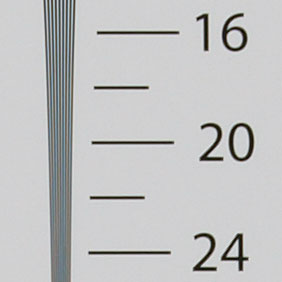 | 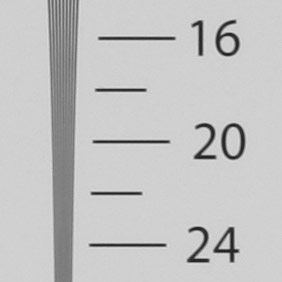 | |
2200 lpph, ZD 12-60mm at 25mm, f8, 100 ISO |
1950 lpph, 85mm, f8, 100 ISO | |
Nikon D300 with Nikkor DX 17-55mm f2.8 |
Sony Alpha DSLR-A700 with Sony DT 16-80mm | |
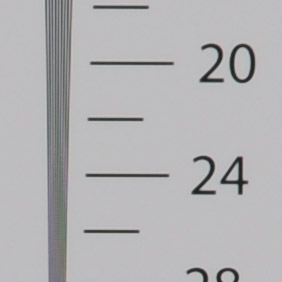 | 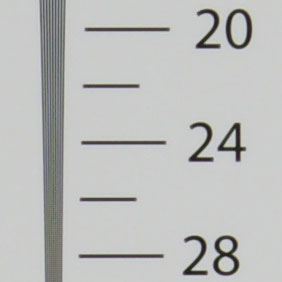 | |
2250 lpph, DX 17-55mm at 35mm, f8, 100 ISO |
2350 lpph, DT 16-80mm at 35mm, f8, 100 ISO |
Olympus E-3 with Zuiko Digital 12-60mm 1:2.8-4 SWD |
Canon EOS-40D with Canon EF 85mm f1.8 USM | |
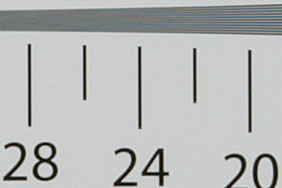 | 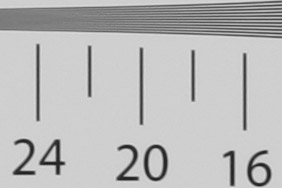 | |
2200 lpph, ZD 12-60mm at 25mm, f8, 100 ISO |
2100 lpph, 85mm, f8, 100 ISO | |
Nikon D300 with Nikkor DX 17-55mm f2.8 |
Sony Alpha DSLR-A700 with Sony DT 16-80mm | |
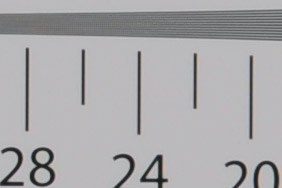 | 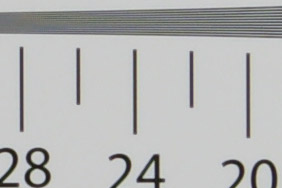 | |
2300 lpph, DX 17-55mm at 35mm, f8, 100 ISO |
2400 lpph, DT 16-80mm at 35mm, f8, 100 ISO |
Olympus E-3 Studio resolution: JPEG versus RAW
We photographed the test chart in the E-3’s RAW plus Large Fine JPEG mode, allowing us to directly compare images created from exactly the same data. Below are crops taken from the original JPEG file alongside the RAW version, processed in Adobe Camera RAW using the default settings, saved as a 16-bit TIFF, then opened in Photoshop.
As seen on the previous page, Adobe’s RAW conversion has taken a slightly different approach to tone and sharpening, with a slightly softer result that resolves fractionally less ultimate detail. As always though, the benefit of shooting in RAW is being able to further tweak the settings and apply more sophisticated processing, but as seen here and throughout our review, the E-3 can certainly produce some very pleasing images using its in-camera JPEG processing and default settings.
Now let’s check out the camera’s performance at different sensitivities in our Olympus E-3 noise results page.
Olympus E-3 JPEG with Zuiko Digital 12-60mm 1:2.8-4 SWD |
Olympus E-3 RAW with Zuiko Digital 12-60mm 1:2.8-4 SWD | |
 | 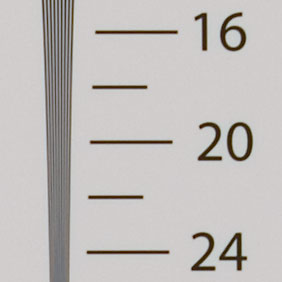 | |
2200 lpph, ZD 12-60mm at 25mm, f8, 100 ISO |
2150 lpph, ZD 12-60mm at 25mm, f8, 100 ISO |
Olympus E-3 JPEG with Zuiko Digital 12-60mm 1:2.8-4 SWD |
Olympus E-3 RAW with Zuiko Digital 12-60mm 1:2.8-4 SWD | |
 | 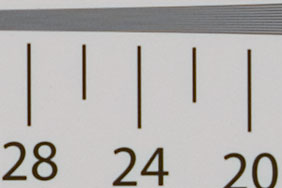 | |
2200 lpph, ZD 12-60mm at 25mm, f8, 100 ISO |
2150 lpph, ZD 12-60mm at 25mm, f8, 100 ISO |



